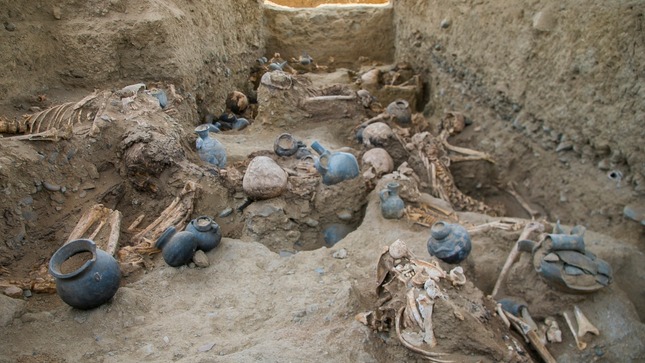When you buy through links on our site , we may earn an affiliate commission . Here ’s how it form .
In the fifteenth 100 , a chemical group of elect women in the ancient city of Chan Chan spent their days making textiles while living … and in death .
archeologist recently expose a mass grave in the Trujillo province of modern - twenty-four hour period Peru that hold the stiff of about 25 people , mostly women and a couple of children and teenagers , surrounded by cloth tools , including needle , spindles and chalk , according to a statementfrom the Peruvian Ministry of Culture .

Archaeologists discovered around 25 skeletons in a mass grave in Peru.
Because the women were buried with these point , they were potential " people dedicated to textile , " according to the statement . The women were buried in a seated position , with their legs bent , and most were under eld 30 .
Related : In exposure : Moche hoarded wealth veil in Peru temple
" It is a very specific population , not too vernal considering the average human life span was 40 years , " Jorge Meneses Bartra , an archaeologist who leads the research projection , told Andina , a Peruvian news authority . The skeleton were wrapped with a cotton plant cloth that was then covered with another fabric made from plant life tissue .

The number of grave good found in the solemn perdition — including stacks of ceramic objects — suggest that the people buried were elite group , according to Smithsonian Magazine .
Archaeologists uncover the mountain tomb , which stretch 32 feet ( 10 beat ) long and wide , sealed with clay that contained jar fragments , which may have dish out as a tomb marker , according to the statement .
The ancient city of Chan Chan , which means " splendiferous Dominicus " in the Chimú language , was the largest city in pre - Columbian America and the capital of the Chimú Empire , which was known to perform rituals demand human forfeiture , harmonise to the BBCandBritannica . The empire reached its height in the fifteenth hundred , before theIncasconquered it around A.D. 1470 .

archaeologist have yet to come up any evidence that the human remains in the recently expose grave were the resultant of such sacrifices ; in fact , the investigator do n’t yet hump how the masses choke , Meneses said in the program line .
— photograph : Ancient circular geoglyphs etch into the sand in Peru
— pic : The amazing mummies of Peru and Egypt

— In photos : Moche treasure hidden in Peru temple
However , the archaeologists do conceive that there were two separate great deal burials in the same tomb . Within the grave , the archaeologists discovered one systema skeletale that " maintains its anatomical position " and another whose bones were jumble and exposed to the constituent , according to the statement .
This finding suggests that the ancient people sink some of these individuals right after they died and some subsequently on . They in all likelihood institute the corpse of the second group of hoi polloi from another burial place , according to the researchers .

" This shows that the Chimu used to relocate and rig their deceased , " Sinthya Cueva García , theatre director of the Chan Chan Archaeological Complex Special Project ’s Archaeological Research Program , said in the statement .
Originally publish on Live Science .












